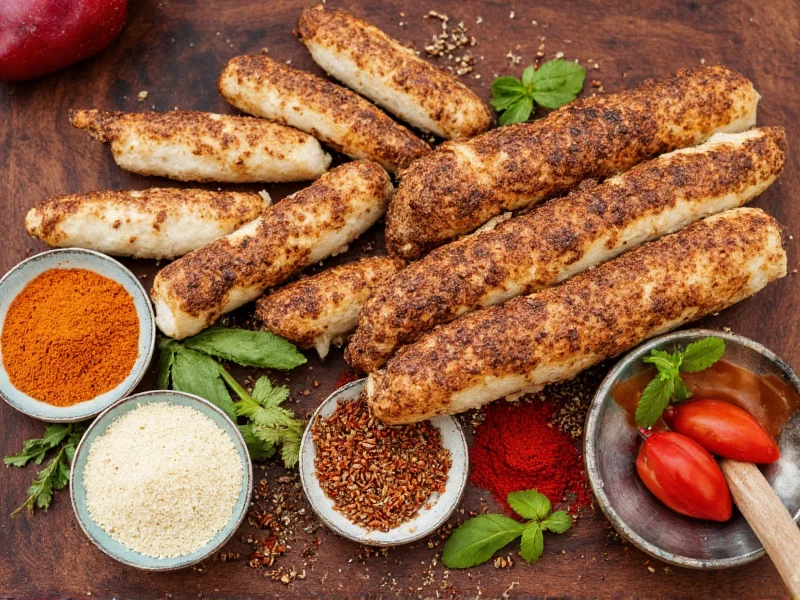The Core Flavor Profile of Authentic Banh Mi
Understanding banh mi spices requires recognizing that Vietnamese cuisine emphasizes freshness and balance over complex spice mixes. Unlike many other Southeast Asian cuisines that rely on elaborate curry pastes or spice blends, authentic banh mi focuses on a few key ingredients that work in harmony.
The magic of banh mi lies not in a proprietary spice blend but in the careful balance of five fundamental taste elements: salty, sweet, sour, spicy, and umami. This balance creates the distinctive flavor profile that has made banh mi sandwiches beloved worldwide.
Essential Banh Mi Seasoning Components
While "spices" is part of the search query, it's important to clarify that traditional banh mi preparation uses relatively few dried spices compared to other global cuisines. The flavor comes primarily from fresh ingredients and simple seasonings.
| Ingredient | Role in Banh Mi | Traditional Usage |
|---|---|---|
| Coriander (ground) | Earthy base note | Used in pâté and meat marinades |
| Black pepper (freshly ground) | Subtle heat and complexity | Added to meats and fillings |
| Garlic (fresh) | Aromatic foundation | Mixed into pâté and meat marinades |
| Fish sauce | Umami and saltiness | Base for marinades and sauces |
| Sugar (white or palm) | Sweetness for balance | Counteracts saltiness in marinades |
Why Banh Mi Doesn't Use Complex Spice Blends
Many Western interpretations of banh mi mistakenly add spices like cumin, turmeric, or chili powder that aren't traditional in authentic Vietnamese banh mi. These additions often come from confusion with other Southeast Asian cuisines.
Traditional Vietnamese cooking, particularly for banh mi, follows these principles:
- Freshness over complexity - Prioritizing fresh herbs like cilantro and mint rather than dried spice mixes
- Balance of flavors - Creating harmony between salty (fish sauce), sweet (sugar), sour (pickled vegetables), and spicy (chili)
- Enhancement rather than domination - Seasonings should complement the main ingredients, not overpower them
Creating Authentic Banh Mi Flavor at Home
When preparing banh mi at home, focus on these essential techniques rather than searching for a secret spice blend:
Meat Marinade Essentials
The most "spiced" component of banh mi is typically the meat marinade. For traditional grilled pork (thit nuong), the marinade includes:
- Fish sauce (3-4 tablespoons)
- Garlic (2-3 cloves, minced)
- Coriander (1 teaspoon ground)
- Black pepper (½ teaspoon freshly ground)
- Sugar (2 tablespoons)
- Water or broth (¼ cup)
This simple marinade transforms ordinary pork into the flavorful filling that defines a great banh mi. The key is allowing sufficient marinating time (at least 4 hours, preferably overnight) for flavors to penetrate.
The Role of Fresh Herbs and Pickled Vegetables
While not spices, these components provide the aromatic complexity that many mistake for spice blends:
- Cilantro - Adds bright, citrusy notes
- Scallions - Provides mild onion flavor without overpowering
- Pickled daikon and carrot - Contributes sour and sweet elements that balance the savory meats
- Chili peppers - Adds heat when desired
Regional Variations in Banh Mi Seasoning
While Saigon-style (southern Vietnam) banh mi represents what most Westerners recognize, regional differences exist:
- Southern Vietnam - Slightly sweeter profile with more sugar in marinades
- Central Vietnam - More emphasis on fish sauce and black pepper, with less sweetness
- Northern Vietnam - Often features more garlic and less chili
These subtle variations reflect local taste preferences rather than fundamentally different spice blends. The core seasoning components remain consistent across regions.
Common Misconceptions About Banh Mi Spices
Several misconceptions persist about banh mi seasoning, often stemming from Western adaptations:
- Myth: Banh mi requires special spice blends or curry powders
Reality: Authentic recipes use minimal dried spices, focusing on fresh ingredients - Myth: Cumin is a traditional banh mi spice
Reality: Cumin appears in some Westernized versions but isn't traditional in Vietnamese banh mi - Myth: Banh mi has a complex, secret spice mix
Reality: The distinctive flavor comes from technique and balance, not hidden ingredients
Practical Tips for Perfect Banh Mi Flavor
When preparing banh mi at home, these techniques will yield more authentic results than searching for exotic spices:
- Use fresh garlic - Never substitute garlic powder in authentic banh mi preparation
- Balance fish sauce carefully - Start with less and adjust to taste, as brands vary in saltiness
- Marinate meats properly - Allow at least 4 hours for flavors to develop
- Make your own pickled vegetables - The quick-pickled daikon and carrot are essential for authentic flavor
- Use high-quality baguette - The bread's texture and slight sweetness complement the seasonings
Remember that the essence of banh mi lies in the harmony of simple ingredients rather than complex spice blends. By focusing on fresh components and proper technique, you'll achieve the authentic banh mi flavor profile that has captivated food lovers worldwide.











 浙公网安备
33010002000092号
浙公网安备
33010002000092号 浙B2-20120091-4
浙B2-20120091-4